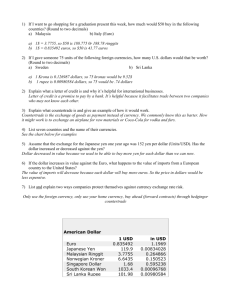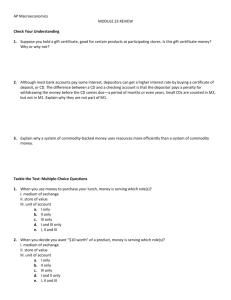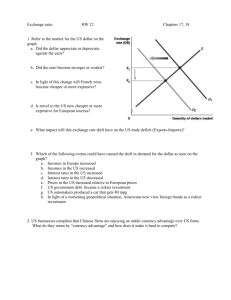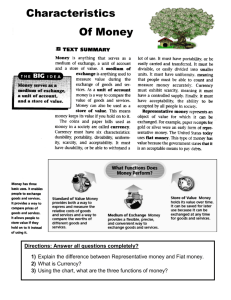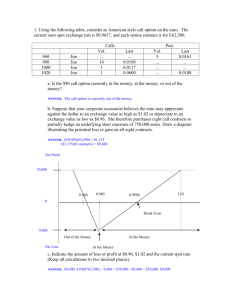Study Guide: Final
advertisement
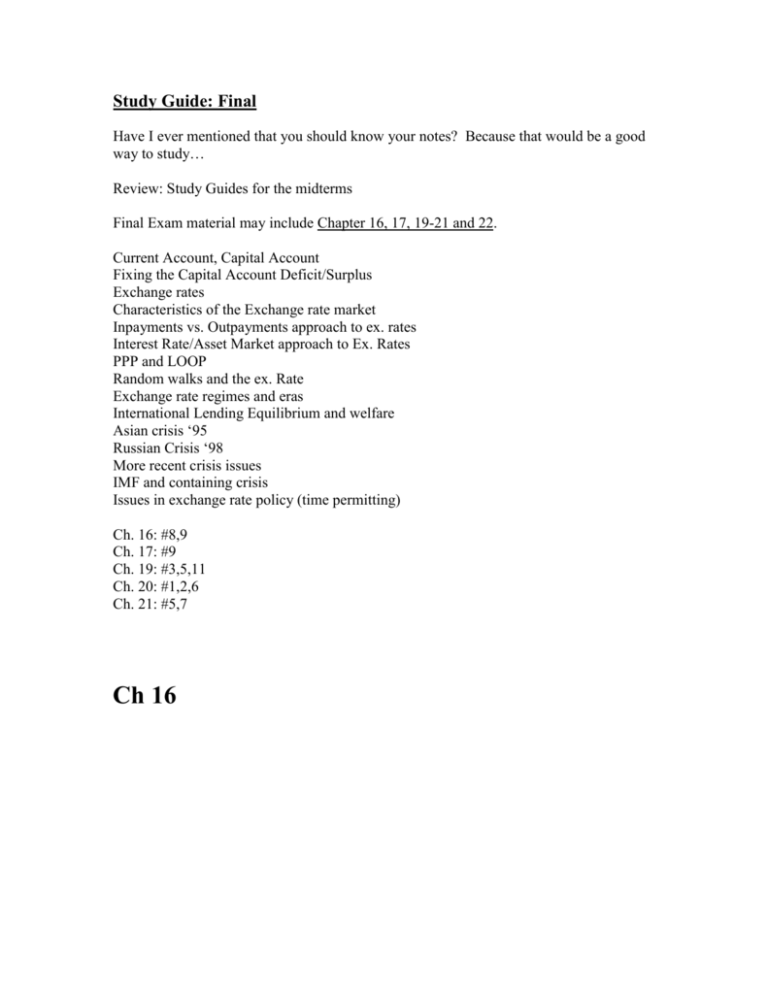
Study Guide: Final Have I ever mentioned that you should know your notes? Because that would be a good way to study… Review: Study Guides for the midterms Final Exam material may include Chapter 16, 17, 19-21 and 22. Current Account, Capital Account Fixing the Capital Account Deficit/Surplus Exchange rates Characteristics of the Exchange rate market Inpayments vs. Outpayments approach to ex. rates Interest Rate/Asset Market approach to Ex. Rates PPP and LOOP Random walks and the ex. Rate Exchange rate regimes and eras International Lending Equilibrium and welfare Asian crisis ‘95 Russian Crisis ‘98 More recent crisis issues IMF and containing crisis Issues in exchange rate policy (time permitting) Ch. 16: #8,9 Ch. 17: #9 Ch. 19: #3,5,11 Ch. 20: #1,2,6 Ch. 21: #5,7 Ch 16 1. A country's balance of payments records: A. The value of all exports of goods and services from that country of a period of time. B. All flows of value between that country's residents and residents of the rest of the world during a period of time. C. All flows of financial assets that cross that country's borders during a period of time. D. All flows of goods into that country during a period of time. 2. In a nation's balance of payments, which one of the following items is always recorded as a positive entry? A. Changes in foreign currency reserves. B. Imports of goods and services. C. Military foreign aid supplied to allied nations. D. Purchases by foreign travelers visiting the country. 3. An increase in a nation's financial liabilities to foreign residents is a __________. A. Reserve inflow. B. Reserve outflow. C. Capital inflow. D. Capital outflow. 4. The net value of flows of goods, services, income, and unilateral transfers is called the: A. Capital account. B. Current account. C. Trade balance. D. Official reserve balance. 5. A deficit in the current account: A. Tends to cause a surplus in the capital account. B. Tends to cause a deficit in the capital account. C. Has no relationship to the capital account. D. Is the result of increasing exports and decreasing imports. 6. Which of the following transactions is recorded in the capital account? A. Ford motor company builds a new plant in China B. A Chinese businessman imports Ford automobiles from the United States. C. A US tourist spends money on a trip to China. D. The New York Yankees are paid $10 million by the Chinese to play an exhibition game in Beijing, China. 7. Official reserve assets are: A. The gold holdings in the nation's central bank. B. Moneylike assets that are held be governments and that are recognized by governments as fully acceptable for payments between them. C. Government T-bills and T-bonds. D. Government holdings of SDR's 8. A statement of the stocks of a nation's international assets and foreign liabilities at a point in time is the country's __________ investment position. A. Public B. Private C. Domestic D. International Ch 17 1. Suppose that a Korean television set that costs 600 won in Korea costs $400 in the United States. These prices suggest that the exchange rate between the won and the dollar is: A. 1.5 won per dollar B. 0.75 won per dollar C. $1.50 per won D. $3 per won 2. The _____ exchange rate is the price set now for an exchange that will take place sometime in the future. A. Current B. Forward C. Future spot D. Spot 3. Which of the following is NOT a function of the interbank operations of the foreign exchange market? A. Provides a bank with a continuous stream of information on conditions in the foreign exchange market. B. Provides a bank the means to readjust its own position quickly and at low cost. C. Permits a bank to take on a position in a foreign currency quickly. D. Provides a bank with technological resources for use in foreign exchange trading. 4. U.S. exports of goods and services will create a __________ foreign currency and a __________ U.S. dollars. A. Demand for; supply of B. Supply of; demand for C. Shortage of; demand for D. Supply of; shortage of 5. Shifts in demand away from French products and toward U.S. products (caused by forces other than changes in the exchange rate) would result in extra attempts to __________ euros and __________ dollars. A. Buy; buy B. Sell; sell C. Sell; buy D. Buy; sell 6. In a __________ exchange rate system the government or central bankers intervene to keep the exchange rate virtually fixed (or pegged). A. Fixed B. Market drive C. Floating D. Managed float 7. Exchange rates are equalized in different locations due to: A. Arbitrage. B. Government intervention in foreign exchange markets. C. Free trade in goods and services. D. The actions of importers and exporters. Ch19 1. An expected depreciation in the euro will lead to: A. An inflow of capital to Europe. B. An increase in the demand for euro-denominated financial assets. C. Uncovered interest rate parity. D. A decrease in the demand for euro-denominated financial assets. 2. An increase in interest rates in the United States will lead to: A. Depreciation of the dollar. B. Outflows of capital from the United States. C. Capital inflows into the United States. D. A decrease in the demand for dollar-denominated financial assets. 3. Suppose the average price of a Big Mac in the United States is $3.50 while in Japan the average price is 400 yen. If the price of a dollar is 100 yen per dollar, the purchasing power parity model of exchange rate determination suggests: A. The yen is overvalued. B. The yen is undervalued. C. The price of a Big Mac in Japan will rise. D. The dollar will depreciate against the yen. 4. Exchange rates are determined in the long-run by: A. Interest rate differentials. B. Real growth rates. C. Purchasing power parity. D. Financial asset pricing. 5. Studies of exchange rate prediction models conclude that: A. Structural economic models cannot reliably out predict the naïve alternative of a random walk for short forecast horizons. B. Structural economic models reliably out predict the naïve alternative of a random walk for short forecast horizons. C. Structural economic models cannot reliably out predict the naïve alternative of a random walk for long forecast horizons. D. Structural economic models reliably out predict the naïve alternative of a random walk for long forecast horizons. Ch_20 1. With a _______, government allows the market to determine the exchange rate of a currency. A. Adjustable peg B. Dirty float C. Managed float D. Clean float 2. Under which of the following policies does the government enter the foreign exchange market and buy or sell foreign currency in order to influence the market-determined exchange rate of the domestic currency? A. Exchange controls B. Capital controls C. Official interventions D. Adjustable pegs 3. An exchange rate regime in which the government may change the fixed rate in the face of a significant disequilibrium in the country's international position is called a(n) _______. A. Pegged exchange rate. B. Fixed exchange rate. C. Adjustable peg. D. Managed float. 4. Pressures in the foreign exchange rate market are such as to cause the British pound to depreciate with respect to the U.S. dollar. If the British government intervenes in the foreign exchange market to maintain a fixed exchange rate with respect to the U.S. dollar, it can be concluded that: A. Britain is financing a surplus in their balance of payments. B. The money supply in Britain will rise. C. Britain is financing a deficit in their balance of payments. D. Britain is gaining foreign reserves. 5. If a country's currency is _______, then it can borrow from other countries by issuing assets that will be held as reserves by the central banks of other countries. A. Pegged B. Floating C. A reserve currency D. Depreciating. Ch_21 (time permitting) 1. Which of the following is a major benefit of international lending? A. It allows intertemporal trade to take place. B. It allows lenders and investors to diversity their investments more broadly. C. It encourages countries to reduce taxes in the domestic market. D. Both (a) and (b) are correct. 2. Borrowers in wealthy countries would gain if: A. All restrictions on capital flows between nations were removed. B. Capital flows between nations are prohibited. C. Factor-price-equalization takes place. D. Governments allowed free markets to determine interest rates. 3. Which of the following debt crises involved the IMF refusing to pay an installment of a loan to a country in trouble and the country restructuring its debt, effectively wiping out most of the creditors' value? A. The debt crisis of 1982 B. The Asian crisis of 1997 C. The Mexican Crisis of 1994-1995 D. The Russian crisis of 1998 4. Which of the following is a plausible effect of a rescue package? (I) The rescue package can compensate for the lack of private lending during the crisis. (II) The rescue package can restore investor confidence by ensuring that there is no moral hazard problem. (III) The rescue package can limit any contagion effects. (IV) The rescue package includes conditions from the IMF that should speed the end of the financial crisis. A. I, II, and III B. I, III, and IV C. II, III, and IV D. I, II, III, and IV 5. Which of the following are reform measures that have been suggested to reduce the frequency of financial crises? (I) Developing countries should pursue sound macroeconomic policies. (II) Countries should improve the quality and timeliness of the data they report on their international reserves and debt. (III) Countries should avoid short-term borrowings in the domestic currency and should stick to borrowing in foreign currencies only. (IV) Countries should strive for better supervision and regulation of their banks. A. I, II, and III B. II, III, and IV C. I, II, and IV D. I, II, III, and IV 6. IMF programs generally: A. Involve debt forgiveness. B. Impose conditions on lending. C. Are designed to encourage rapid economic growth. D. Involve the use of tariffs and quotas. Ch_22 (time permitting) 1. Fiscal policy consists of: A. Changes in money supply and interest rates. B. Changes in government expenditures or taxes. C. Changes in exchange rate par values. D. Changes in the official settlements balance. 2. The locomotive theory posits that: A. Growth in one or more large countries will retard the growth of smaller countries dependant on exports. B. Growth in one or more large countries will lead smaller countries o open their economies. C. An increase in exports will lead to an increase in imports. D. Growth in one or more large countries can raise growth in other smaller countries that trade with these larger countries. 3. An increase in government spending will: A. Shift the IS curve to the left. B. Shift the IS curve to the right. C. Increase the slope of the IS curve. D. Shift the LM curve to the right. 4. The LM curve illustrates: A. All combinations of domestic output levels and interest rates for which the domestic goods market is in equilibrium. B. All combinations of domestic output levels and interest rates for which the domestic money market is in equilibrium. C. All combinations of domestic output levels and interest rates that results in a zero balance for the country's official settlements balance. D. All combinations of domestic output levels and interest rates for which there is full employment. 5. The official settlements balance is in _______ if the IS-LM intersection is _______ the FE curve. A. Surplus; on B. Surplus; to the right of C. Deficit; to the left of D. Balance; on 6. The FE curve illustrates: A. All combination\ns of domestic output levels and interest rates for which the domestic goods market is in equilibrium. B. All combinations of domestic output levels and interest rates for which the domestic money market is in equilibrium. C. All combinations of domestic output levels and interest rates that results in a zero balance for the country's official settlements balance. D. All combinations of domestic output levels and interest rates for which there is full employment. ANSWERS, Ch. 16: 1=B, 2=D, 3=C, 4=B, 5=A, 6=A, 7=B, 8=D ANSWERS, Ch. 17: 1=A, 2=B, 3=D, 4=B, 5=C, 6=A, 7=A ANSWERS, Ch. 19: 1=D, 2=C, 3=A, 4=C, 5=A ANSWERS, Ch. 20: 1=D, 2=C, 3=C, 4=C, 5=C ANSWERS, Ch. 21: 1=D, 2=B, 3=D, 4=B, 5=C, 6=B ANSWERS, Ch. 22: 1=B, 2=D, 3=B, 4=B, 5=D, 6=C



